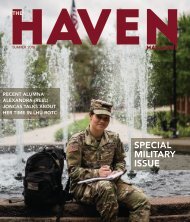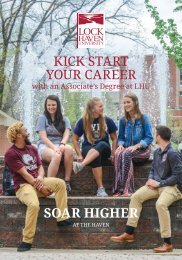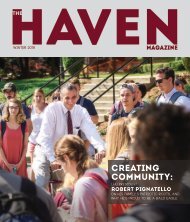The Haven Magazine Spring 2018
Create successful ePaper yourself
Turn your PDF publications into a flip-book with our unique Google optimized e-Paper software.
FROM THE ARCHIVES<br />
Technology in the Age of Electricity: <strong>The</strong> Central<br />
State Normal School in the 1890s<br />
by Joby Topper, LHU Library Director<br />
We live in the Computer<br />
Age, a period of rapid<br />
advancement in computer<br />
miniaturization, digital<br />
communications, robotics, and other<br />
areas of high technology. It’s an exciting<br />
time to be alive.<br />
<strong>The</strong> “Age of Electricity”—the 1880s and<br />
90s—was a similar time in our history. It<br />
was the age of Edison, Tesla, and Bell,<br />
among others. <strong>The</strong>ir discoveries and<br />
inventions brought about a revolution in<br />
communications, power generation, and<br />
transportation.<br />
<strong>The</strong> catalogs of the former Central<br />
State Normal School (now Lock <strong>Haven</strong><br />
University) draw attention to the various<br />
electrical wonders that were available at<br />
our school. <strong>The</strong>se catalogs were, after all,<br />
recruiting tools. <strong>The</strong>y were disseminated<br />
to high schools all across Pennsylvania.<br />
<strong>The</strong>y were meant to catch the attention<br />
of prospective students and their parents.<br />
Our school was one of the first in the<br />
nation to be fully equipped with electric<br />
lighting. This gave us a competitive<br />
advantage over schools that were still lit<br />
by oil and gas:<br />
“At night the whole building is brilliantly<br />
illuminated with the electric light. Four<br />
hundred and fifty electric lamps are<br />
distributed among two hundred rooms.<br />
… <strong>The</strong>re are no oil lamps to fill and trim.<br />
<strong>The</strong> student needs only to touch a spring<br />
and immediately he has splendid, clean,<br />
and harmless electric light.”<br />
Our catalog writers knew that prospective<br />
students would likely be impressed by the<br />
convenience of electric lighting, and that<br />
parents would just as likely be impressed<br />
by the relative safety of electric lighting<br />
compared to oil and gas.<br />
<strong>The</strong> catalog also includes a hook for the<br />
curious student who needs to understand<br />
how it all works—from the steam engine,<br />
to the dynamo, to the light bulb.<br />
“<strong>The</strong> school equipment includes one<br />
40-horse power Ball automatic engine, …<br />
one Edison dynamo with ampere metre,<br />
volt metre, and all necessary appliances,<br />
with many other interesting pieces of<br />
machinery. <strong>The</strong> student is associated with<br />
the teacher or engineer in the running<br />
and caring for the several machines, and<br />
is thus given the opportunity to become<br />
thoroughly familiar with the details of<br />
each.”<br />
incentive to enroll at the Central State<br />
Normal School.<br />
<strong>The</strong> writer also mentions two of the<br />
most popular devices of the time: an<br />
“Edison Improved Phonograph, capable<br />
of recording and reproducing every<br />
form of sound” and a “Bell Telephone<br />
complete with Blake Transmitter.” <strong>The</strong><br />
writer’s use of the words “improved”<br />
and “complete with Blake Transmitter”<br />
distinguishes these two inventions from<br />
earlier, less successful versions of Edison’s<br />
phonograph and Bell’s telephone and<br />
thus reflects the school’s progressive<br />
attitude. Although our school had just<br />
one phonograph and one telephone,<br />
many schools had neither. Our students<br />
enjoyed “telephonic and telegraphic<br />
communication with all parts of the<br />
city and with the neighboring towns<br />
and cities.” In 1890, this range of<br />
communication was truly remarkable.<br />
<strong>The</strong> Age of Electricity also produced<br />
advances in transportation, notably<br />
the electric street railway. Streetcars<br />
connected the Normal School to<br />
downtown Lock <strong>Haven</strong>, Flemington, and<br />
Mill Hall. A student could ride downtown<br />
and back for a nickel. <strong>The</strong> streetcar<br />
service closed in 1930, but it lives on in<br />
the university trolley, which was designed<br />
to look like the old streetcars.<br />
Sketch of the Dynamo Room and a Student’s Room, from<br />
the CSNS Catalog of 1890-91<br />
For a technophile of the 1890’s, the<br />
prospect of hands-on instruction in<br />
electrical engineering was a powerful<br />
Sketch of a streetcar approaching the Normal School, ca. 1895<br />
LOCK HAVEN UNIVERSITY THE HAVEN SPRING <strong>2018</strong><br />
25











